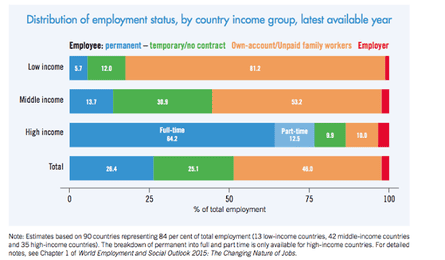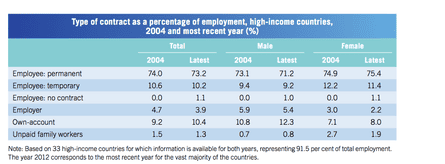A global shift to more insecure jobs since the financial crisis is fuelling growing inequality and higher rates of poverty, according to a new report that estimates only a quarter of the world’s workers are on permanent contracts.
The International Labour Organization (ILO) said the remaining three quarters are employed on temporary or short-term contracts, working informally often without any contract, are self-employed or are in unpaid family jobs.
A worldwide trend away from secure jobs risked “perpetuating a vicious circle of weak global demand and slow job creation” that has dogged many countries since the crisis, the UN agency said.
In its World Employment and Social Outlook 2015 (WESO), the agency highlighted a rise in part-time employment, especially among young women. Though some workers welcome the flexibility of part-time jobs and self-employment, often such roles are down to lack of choice, it said.
Only one in four in secure work

“In some cases, non-standard forms of work can help people get a foothold into the job market. But these emerging trends are also a reflection of the widespread insecurity that’s affecting many workers worldwide today,” said ILO director-general Guy Ryder.
“The shift we’re seeing from the traditional employment relationship to more non-standard forms of employment is in many cases associated with the rise in inequality and poverty rates in many countries,” added Ryder.
“What’s more, these trends risk perpetuating the vicious circle of weak global demand and slow job creation that has characterised the global economy and many labour markets throughout the post-crisis period.”
The report found that the number of people on wage and salaried work – as opposed to forms of work such as self-employment or without contracts – was growing worldwide but less than half, or 42%, of those were on a permanent contract.
Workers on wages or salaries still accounted for only half of global employment, with wide variations across regions.
The report’s main author, Raymond Torres, noted that in developing countries wage and salaried work was growing at a slower pace than before the crisis, while in advanced economies such jobs were not growing and weredeclining in some cases – such as in the UK.
Secure jobs decline in rich countries

There were signs of declining employment security in high-income countries since the financial crisis, Torres said, flagging up the rise of self-employment, of workers without contracts and those who were involuntarily working part-time.
“The remuneration of people on these types of contract tends to be less,” added Torres, director of the ILO research department.
The report drew a link between widespread insecurity at work and rising income inequality in many countries. “The income gap between permanent and non-permanent workers has increased over the past decade,” it said.
The ILO is urging policymakers to consider extending social protection such as pensions and unemployment benefit to workers in less secure forms of employment. It said that globally only 16% of the self-employed were part of a pension scheme, compared with 52% of employees.
Torres cited Chile, China and Brazil as examples of countries that were moving towards great social protection for the self-employed and said the evidence suggested such policies did not harm employment rates.
“Some people have said by moving in this direction to social protection or more regulations you have fewer jobs but that’s not the case,” he said.
Women doing worse since crisis

The ILO also highlighted a comparatively slower recovery in female unemployment rates since 2009 in many regions, including the European Union.
The report found that the rise in the number of part-time jobs outpaced gains in full-time jobs between 2009 and 2013 in the vast majority of countries with available information.
“In France, Italy, Japan, Spain and the European Union more broadly, increases in part-time employment occurred alongside losses in full-time jobs – leading in some instances to overall job losses during this period ... Much of the increase in part-time employment has been involuntary,” the report said.

Comments (…)
Sign in or create your Guardian account to join the discussion